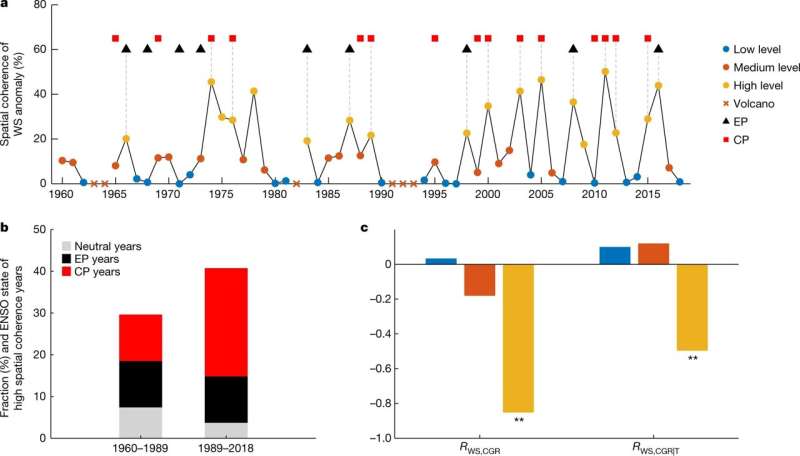Droughts increasingly reduce carbon dioxide uptake in the tropics, finds study

Plants take in CO2 to grow. They extract it from the atmosphere and use it to build organic compounds by means of photosynthesis and water. Terrestrial ecosystems have absorbed an average of about 32 percent of CO2 emissions caused by human activity over the last six decades. Whether and to what extent terrestrial vegetation can continue to function as a carbon sink in a changing climate is a key question in climate science and is of vital political relevance.
The Earth’s climate system features numerous feedback loops. These are processes triggered by global warming that have a feedback effect on climate change and either amplify or diminish it. Such carbon system feedback loops are difficult to measure and model, and represent a major factor of uncertainty in climate projections. “It is therefore difficult to quantify exactly how terrestrial carbon sinks will respond to additional human-induced climate change,” says Sonia Seneviratne, Professor for Land-Climate Dynamics at ETH Zurich.
Until now, the available literature suggested that terrestrial carbon sinks might only be clearly affected by a high to very high rise in global warming, i.e. above 2 to 4 degrees Celsius. Now, a team of researchers led by Seneviratne has found evidence that terrestrial ecosystems may be less resilient to climate change than previously thought.
“We have found that tropical carbon sinks are becoming increasingly vulnerable to water scarcity,” says Laibao Liu, a postdoctoral researcher in Seneviratne’s group and first author of the study, which the researchers have published in the journal Nature.
Feedback loop between carbon and climate
The results suggest that droughts have had a growing impact on the carbon cycle in the tropics over the last 60 years, with vegetation absorbing increasingly less CO2 during drought events—an effect that most climate models cannot capture.
Nevertheless, the observed change seems to be based on a known feedback loop: under hot and dry conditions, plants stop absorbing CO2 to avoid water loss. In addition, there can also be an increase in plant mortality and fire events, which leads to the additional release of CO2 into the biosphere. If such conditions were to occur more often, it could lead to a reduction in the terrestrial CO2 sink, and thus to a further increase in global warming.
Already back in 2018, Seneviratne’s team demonstrated on a global scale how stressed ecosystems absorb less carbon during severe droughts—namely, how the CO2 concentration in the atmosphere increases significantly in dry years. In fact, the growth rate of atmospheric CO2 varies from year to year in line with terrestrial water availability.
The greatest challenge was to find out where droughts were occurring worldwide. Sophisticated satellite observation of Earth’s water reservoirs have since enabled this to be determined more precisely.
Droughts correlate with the carbon cycle
In this study, the researchers wanted to find out whether there was a change in the correlation between water availability and CO2 growth rate over time. “Since annual fluctuations in CO2 growth rates are clearly dominated by carbon fluxes between land and atmosphere in the tropics, we were able to investigate this global question using tropical climate data from the last sixty years,” Liu explains.
In particular, the researchers were able to demonstrate that the coupling between tropical water availability and CO2 growth rates intensified in the 30-year period between 1989 and 2018 when compared to the period from 1960 to 1989.
In other words, tropical water—or more precisely its scarcity—has become an increasingly limiting factor shaping the annually fluctuating carbon cycle and its feedback loops.
Hindsight is not a forecast
The findings do give Seneviratne cause for concern, as they highlight a process that could intensify global warming. She now wants to find out what has caused the increasingly severe tropical droughts and higher sensitivity of tropical ecosystems, and why climate models are not capturing these features. One possible explanation could be changes in the spatial characteristics of the El Niño Southern Oscillation (ENSO), as the researchers write in their study. But it is too early to come up with definite answers.
Seneviratne also urges caution against jumping to conclusions. “Our study looked at historical data—not directly at projections. The results provide no forecasts,” the climate researcher stresses.
Nevertheless, any increase in the effect of droughts on the carbon cycle would not bode well. “We expect many regions with extensive vegetation, especially the Amazon in the tropics, to be more affected by droughts as temperatures rise,” Seneviratne adds.
The fact that climate models fail to reflect the increased role of water limitation could mean that plant carbon uptake and the resilience of vegetation to droughts have been overestimated. “This would affect the assessment of climate targets and measures and make it necessary for us to recalculate the global carbon budget for the remaining emissions,” Liu adds.
The climate models must first of all be able to adequately take into account the consequences of droughts on the carbon cycle, however. “Only then can we make more accurate projections for future carbon sinks on land,” Sonia Seneviratne says.
More information:
Laibao Liu et al, Increasingly negative tropical water–interannual CO2 growth rate coupling, Nature (2023). DOI: 10.1038/s41586-023-06056-x
Citation:
Droughts increasingly reduce carbon dioxide uptake in the tropics, finds study (2023, June 1)
retrieved 1 June 2023
from https://phys.org/news/2023-06-droughts-carbon-dioxide-uptake-tropics.html
This document is subject to copyright. Apart from any fair dealing for the purpose of private study or research, no
part may be reproduced without the written permission. The content is provided for information purposes only.
For all the latest Science News Click Here
For the latest news and updates, follow us on Google News.

